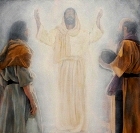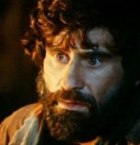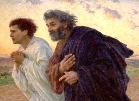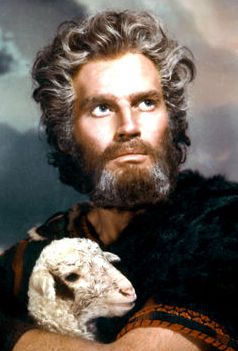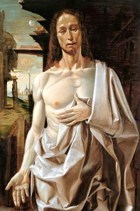Transfiguration of Jesus – extra ideas
WHAT ARE THE FACTS? Symbolism and allegory are all very well, but they feel like camouflage. What are the facts?
This hunger for facts can lead us astray. The facts we keep looking for are perhaps not to be found where we keep looking.
The one fact underlying, this story – it underlies all the stories of the New Testament — is the transformation brought about first of all in the body of Jesus at his death, 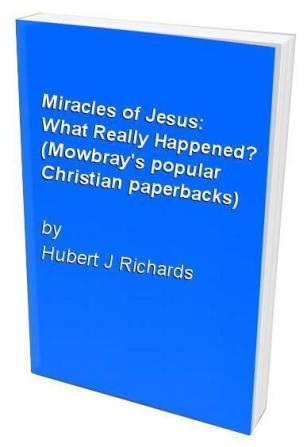 and then in anyone who is granted the vision of that risen Christ and accepts to live by Christ’s Spirit.
and then in anyone who is granted the vision of that risen Christ and accepts to live by Christ’s Spirit.
Whoever has experienced such a transformation in himself knows that the story of Cana is ‘true’ without asking for further ‘facts’ to corroborate it. They are irrelevant. In the eyes of someone like John, or any Christian who has experienced the resurrection of Jesus, the reality that occupies his attention as he tells or reads the story of Cana is that
- on the third day there was a Marriage;
- Jesus was there;
- his Hour had come, and the water turned into Wine, the very best;
- and his disciples saw the Glory of God, and believed.
All the stories told by John end with the word ‘belief’ or ‘faith’. To believe in Jesus is not to believe that he can turn water into wine, like some heavenly magician. To believe in Jesus is to accept him as the one person who can replace our inadequate rituals of purification with the reality of union with God, in the wine of his own blood.
And the whole gospel will finish on the same note:
These things have been written (not in order to keep a record of certain strange things that happened here recently, but) in order to nourish and sustain your faith in Jesus as the Christ and the Salvation of God (John 20:31).
The Miracles of Jesus: what really happened? Hubert J. Richards, Fontana Books, p.37-38
‘Jesus has spoken to his disciples about the glory of the Son of Mary (Mark 8:38). Now, pulling back the veil of suffering which will characterize his death and be the mark of his people’s life in the world in his absence, he shows them what that glory will be like. The Twelve are given a preview of the triumphant, post-Easter Jesus, crowned with glory.
 Why should Elijah and Moses be present with Jesus? Just as Jesus would be taken up to heaven with his humanity intact, so Elijah had been taken directly to heaven (2 Kings 2:11-12) and, in the belief of many, Moses also (Deuteronomy 34:5-7). Moses and Elijah were great prophetic leaders from Israel’s past with whom it would have been easy for people at that time to associate Jesus. Was not Jesus a prophet of the soon-to-appear king?
Why should Elijah and Moses be present with Jesus? Just as Jesus would be taken up to heaven with his humanity intact, so Elijah had been taken directly to heaven (2 Kings 2:11-12) and, in the belief of many, Moses also (Deuteronomy 34:5-7). Moses and Elijah were great prophetic leaders from Israel’s past with whom it would have been easy for people at that time to associate Jesus. Was not Jesus a prophet of the soon-to-appear king?
But it was important for the Twelve to understand both the difference in kind and also the infinite superiority of Jesus to these two great prophets; they could hardly be compared with Jesus or even spoken of in the same breath.
- Jesus was transfigured, or glorified, before the disciples and his clothes became dazzling white; no details are given about the appearance of Moses and Elijah.
- The voice of the Father declared of Jesus, ‘This is my Son, whom I love. Listen to him.’
- The voice addressed the Twelve and demanded that they listen to Jesus and in particular, to what he had said about the suffering of the Messiah and his people (8:31—9:1). But the voice was silent about Moses and Elijah.
In the second half of Mark’s gospel it is important that the Twelve — and the readers – understand who Jesus is. From now on, Mark reminds us that Jesus is not merely the Messiah of Israel, but the Son of Man who is the Son of God (12:6-7; 13:32; 15:39). This becomes the central belief in the creeds of Christianity.’
Mark, The Servant King, Paul Barnett, 1991, p.163-4
‘The great glimpse into glory came for a select group of disciples—Peter, James, and John.
The locale of the event is uncertain. Mt. Hermon (9,200 ft.) and Mt. Meron (about 4,000 ft.) are the most likely candidates because the traditional site of Mt. Tabor (1,900 ft.) is not all that high and was inhabited by a fortress at this time, making it an unlikely spot for such a private experience.
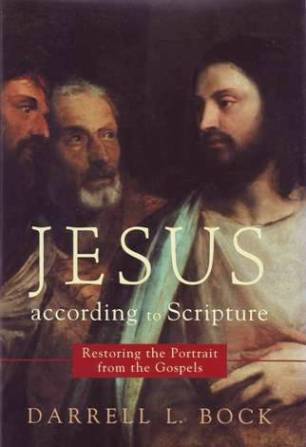 As is common in Luke, the scene takes place in the context of prayer. Jesus is transformed before them into a dazzling, bright form wearing glistening white garments, a description indicative of glory (see Dan. 7:9; 12:3; 2 Baruch 51.3,5, 10,12; Enoch 38.4; 62:15-16; 104.2; Rev. 3:5; 4:4; 7:9).
As is common in Luke, the scene takes place in the context of prayer. Jesus is transformed before them into a dazzling, bright form wearing glistening white garments, a description indicative of glory (see Dan. 7:9; 12:3; 2 Baruch 51.3,5, 10,12; Enoch 38.4; 62:15-16; 104.2; Rev. 3:5; 4:4; 7:9).
With him were Moses and Elijah (Mark has them in the reverse order), who probably represent the law and the eschaton, because Elijah was anticipated as the prophet of the end (Mal. 4:5; Sir. 48:10).
The three are engaged in discussion. Only Luke indicates the topic: Jesus’ “exodus,” which he was to accomplish in Jerusalem.
Glory and suffering both are central to who Jesus is.’
___________________________
‘According to Matthew, the voice causes the disciples to fall down in fear, but Jesus tells them to rise and not to fear. As his disciples, they have access to God’s presence. Then they were alone with Jesus.
The glimpse of glory was over.
- Matthew and Mark note how Jesus instructed them to say nothing about this event until the Son of Man is raised.
- Mark notes that they kept the matter to themselves.
- Luke does not discuss the command but mentions that they were silent in those days about what they had seen.
Again the silence is requested because they still have much to learn before they can appreciate what it is that they have seen.’
Jesus According to Scripture, Darrell Bock, Baker Academic, p.234
Luke alone tells us that Peter and his companions went into a deep sleep, probably tired after a long climb, and then they woke up. All three Gospels tell how they found Jesus talking with Elijah and Moses (whom somehow they recognized). According to Luke, they were talking about Jesus’ departure, presumably meaning his death.
Then Peter made an apparently nonsensical remark, asking whether he should make three shelters for them (surely not an easy task on a mountain top where there was little vegetation), but we are told that he did not know what he was saying. Some commentators think that the mention of making tents is an allusion to God tabernacling with humankind, but this hardly explains three tents. The remark is so perplexing that it is hard to imagine it as a development of the story….
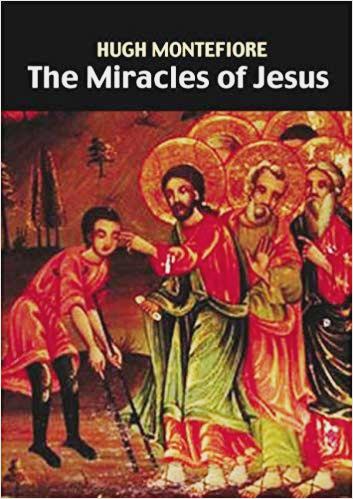 Could it be that this is a piece of symbolic writing such as is found in the apocalytiptic writings of first-century Judaism and early Christianity? There is no known parallel to the story elsewhere. A good many commentators think of it as a legend or symbolic tale; others regard it as an account of a post-resurrection event which has been placed at this point for theological reasons.
Could it be that this is a piece of symbolic writing such as is found in the apocalytiptic writings of first-century Judaism and early Christianity? There is no known parallel to the story elsewhere. A good many commentators think of it as a legend or symbolic tale; others regard it as an account of a post-resurrection event which has been placed at this point for theological reasons.
But none of the resurrection stories contain any trace of transfiguration: on the contrary, there seems to have been some difficulty in recognizing the post-resurrection Jesus from other people, so he must have looked normal.
The fact that the transfiguration of Jesus appears in all three Gospels with a particular date attached to it (even if the date is slightly different in St Luke’s Gospel) is a strong reason against regarding it as a post-resurrection event transferred to the earthly ministry of Jesus. It is misguided to dismiss an account of a phenomenon in its current context because it is contrary to normality.
The religious message of this event is clear: the sonship of Jesus was revealed to him at his baptism by a heavenly voice, and the same sonship is revealed to the inner circle of the Twelve on the Mount of Transfiguration.
The Miracles of Jesus, Hugh Montefiore, SPCK, London 2005, p.68-69

